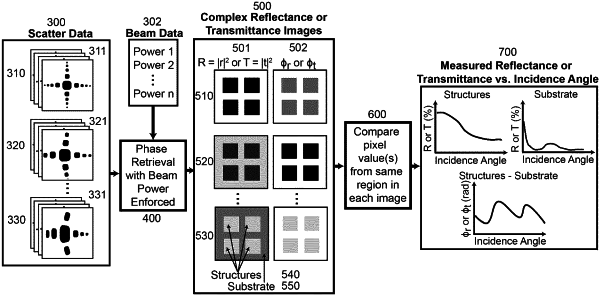| CPC G01N 21/4788 (2013.01) [G01N 21/33 (2013.01); G01N 21/45 (2013.01); G01N 21/4795 (2013.01); G01N 21/956 (2013.01); G01N 2021/1782 (2013.01); G01N 2021/335 (2013.01); G01N 2021/4711 (2013.01); G01N 2201/061 (2013.01)] | 18 Claims |

|
1. The method of determining spatially-resolved material properties from a sample's complex reflectance or transmittance comprising the steps of:
a. providing at least partially spatially-coherent radiation in the form of an incident beam;
b. characterizing the incident beam;
c. delivering the incident beam onto a sample to produce scattered radiation;
d. varying at least one independent parameter of the incident beam upon which the sample's complex reflectance or transmittance is dependent;
e. collecting the scattered radiation at multiple values of the independent parameter on a detector and generating scatter data;
f. generating at least one spatially-resolved, complex image of the sample based upon the beam characterization and the collected scatter data, at each of the multiple values of the independent parameter, without constraining the complex images based on modeled electromagnetic scattering properties of the sample;
g. calculating spatially-resolved complex scattering properties of the sample based on the images;
h. determining spatially-resolved, depth-dependent material properties of the sample from the spatially-resolved complex scattering properties;
i. guessing a population of at least one sample model in which spatially-resolved material properties are assigned a depth;
j. estimating predicted reflectance/transmittance versus the independent parameter based on the sample model;
k. comparing the predicted reflectance/transmittance versus the independent parameter to a calculated measurement of reflectance/transmittance versus the independent parameter; and
l. refining the sample model until the discrepancy between the predicted reflectance/transmittance versus the independent parameter and the measured reflectance/transmittance versus the independent parameter is sufficiently small.
|